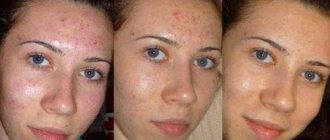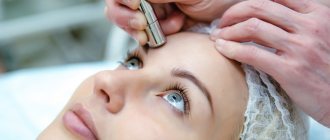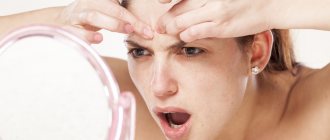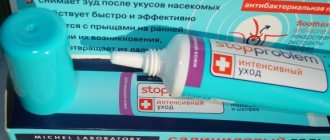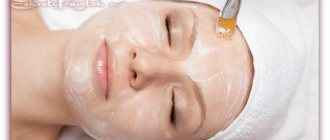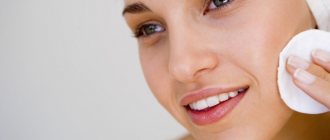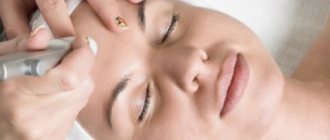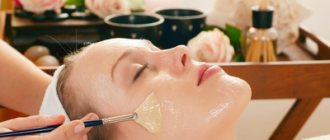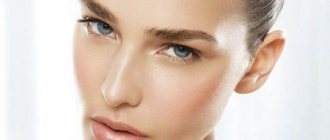Acids are a unique facial skin care product
Usually, the word “acid” conjures up images of smoking vials and test tubes and thoughts of terrible chemical burns. Therefore, at first I somehow don’t believe in skin care with acids. But in fact, when used in the right concentrations, acids are some of the most beneficial ingredients available for skin care.
These are magical remedies used to combat acne, wrinkles, age spots, scars and uneven skin tone. Nowadays, a huge number of products with acids are produced on the cosmetic industry market: cream with acid, mask with acid, gel for washing with acid. In such a variety, it is easy to get confused and it becomes impossible to remember which acid cream to use - and for what - and which brands to buy. Therefore, first of all, you must know the basics of how acids affect the skin.
How the session goes and preparation for it
Salicylic peeling - although superficial, still burns the skin. This is what causes it to exfoliate in the future. Therefore, during the procedure, it is important to observe hygiene and other safety standards that minimize the risk of infection.
The duration of the session is 30–45 minutes. Sometimes a preliminary consultation with a cosmetologist is also added, during which the condition of the client’s skin, the feasibility of the procedure is assessed, the question of the presence of possible contraindications and whether the woman’s expectations correspond to the real effect of this peeling is clarified. The patient is warned about possible complications and given recommendations regarding further skin care. During the conversation, you can and even should ask the specialist all the questions that arise. It would be a good idea to inquire about the qualifications and experience of the cosmetologist and ask to present documents confirming them. Under no circumstances should you hide or distort any information about the state of your own health, wanting to carry out the procedure at all costs. The results for facial skin can be the most disastrous.
The salicylic peeling procedure may not be what the client needs at all, this is clarified during a preliminary conversation with the cosmetologist
Preparing the skin for salicylic peeling begins 2-3 weeks before the scheduled procedure. During this time, visiting the sauna, bathhouse, and swimming pool is prohibited. Exposure of the skin to ultraviolet radiation, both natural and artificial, is unacceptable. Solariums are especially harmful in this regard. Before going outside in sunny weather, apply a protective cream (at least SPF-30) to the skin. Any mechanical impact is undesirable - cleansing the face with scrubs and gommages. It is useful to wash your face with gel or foam with fruit acids or salicylic acid. The latter will help the skin adapt a little to the main component of the peeling. Smoking, if it is impossible to completely quit it, is reduced to a minimum.
The need to protect the face from direct sunlight is one of the main recommendations that must be followed in preparation for salicylic peeling and during the rehabilitation period
If the skin on the face is very rough, for example, as a result of prolonged exposure to direct sunlight, the cosmetologist, as part of the preparation, recommends the use of products with tretinoin, hydroquinone, and kojic acid. Their use significantly reduces the thickness of the layer of keratinized cells, stimulates tissue renewal, and makes the skin more “permeable” to salicylic acid. When you plan to get rid of freckles and age spots, creams with arbutin are indicated.
The session begins with thorough cleansing and degreasing of the skin. Be sure to remove makeup. Next, a special agent is applied to “soften” the surface layers of the epidermis. The degreasing agent also has antiseptic properties. The final result largely depends on the quality of cleansing - the active substance must penetrate the tissue evenly.
This is followed by directly applying a product containing salicylic acid to the face. Most often it is a solution, but it can also be a paste. As a rule, the face is completely covered, less often the product is used spot-on. It is applied in layers using a brush two or three times - forehead, temples, chin, cheeks, nose, if necessary - eyelids and area around the eyes. The exposure time is determined in each case individually. It is not recommended to keep the solution on the skin for more than three minutes after the last layer has dried. Slight tingling and burning is normal. More intense discomfort should be reported to the cosmetologist immediately. The so-called frosting, a frost-like crust on the face, is also normal. This is a mixture of acid and dissolved secretion of the sebaceous glands that crystallizes under the influence of oxygen.
Salicylic peeling is applied as quickly as possible so that the acid has time to act more or less evenly on all areas of the skin.
The final stage is the application of a special neutralizer. Like any acid peel, salicylic peel cannot be washed off with plain water, unless this is expressly provided by the manufacturer’s instructions. Neutralization is required if the UCON complex is present in the composition - it prevents the crystallization of salicylic acid.
Salicylic peeling is washed off with a special neutralizer, unless otherwise specified in the instructions.
Post-peeling care consists of applying a nourishing mask or restorative cream to the face. The product contains bisabolol or aloe extract, which helps soothe irritated skin and ensure faster healing.
Aloe has both a soothing and healing effect, and it also intensely moisturizes the skin.
The best time for salicylic peeling is late autumn or early spring. The weather at this time is usually cloudy and solar activity is minimal. There is no need to carefully protect the skin after the procedure from exposure to natural ultraviolet radiation.
Video: salicylic peeling procedure
Salicylic acid is the most popular acne-fighting acid.
Salicylic acid has been around for a long time. It is well known for its ability to exfoliate the skin and keep pores clear, which helps reduce acne. You'll find it in serums and cleansers in concentrations ranging from 0.5% to 2%, as well as emergency spot treatments for acne.
Salicylic acid is also used in higher concentrations as an exfoliating agent to treat severe acne, acne scars, melasma, age spots and age spots in beauty clinics. This acid is so effective that it is even used in solutions to remove warts. Because salicylic acid is chemically related to aspirin (acetylsalicylic acid), it also has anti-inflammatory properties.
Effective cosmetics with salicylic acid:
Stridex, One-Step Acne Treatment with Salicylic Acid, Alcohol-Free, 90 Soft Wipes
Derma E, Very Clear Acne Scrub, 2% Salicylic Acid & Damage Complex (113 g)
Ecco Bella Leave-In Exfoliant & Salicylic Acid Blemish Eliminator (60ml)
Alba Botanica, Acne Dote, Deep Pore Cleansing with Salicylic Acid, Oil-Free, 6 fl oz (177 ml)
Salicylic (acid) peeling
Beauty salons often offer clients chemical peels. They are distinguished by a complex effect on the dermis, while achieving a key effect - removing the top layer to smooth out the relief, remove scars, scars, bumps and traces of comedones. When carrying out salicylic peeling, concentrated (up to 50%) acid is used.
Indications for use:
- acne;
- dull (gray) skin;
- shallow expression wrinkles;
- excessive activity of the sebaceous glands;
- a large number of closed comedones (so-called wen);
- scars, incl. post-acne, traces of chickenpox;
- pigmentation.
- Contraindications:
- period of pregnancy and lactation;
- diabetes mellitus at any stage;
- open wounds;
- herpes in the active stage;
- oncology.
If your skin is sensitive, you must notify your cosmetologist in advance in order to carry out pre-peel preparation.
Peeling procedure:
- Skin cleansing.
- Spot application of a concentrated composition, starting from the forehead and temples and ending with the nose and chin (these are the most sensitive areas). Depending on the complexity and condition, the peeling is applied in several layers, but not more than 3.
- After the appearance of frost - a white matte film - no more than 10 minutes should pass, after which the composition is neutralized with alkali in the reverse order - first the nose and chin, lastly the temples and forehead.
- The remaining product is removed with a soft sponge, washed off with cool water, after which a softening mask is applied to the face.
- If you plan to leave the room, be sure to apply sunscreen with maximum SPF. It is better to use a protective headgear so as not to further injure the dermis.
- At home, remove the cream with lotion and do not wash your face for 24 hours.
Peeling “works” within a week. All this time, in the morning and evening, it is advisable to treat the face with chlorhexidine. After a couple of days, the skin will begin to peel off; crusts and scabs should not be touched, otherwise spots and scars will appear. The whole process should go naturally.
Chemical peeling is repeated no earlier than after 2-3 months in the same sequence and concentration. In the absence of obvious problems, such a procedure is usually not prescribed, but in some cases it can be recommended as an effective method of non-surgical rejuvenation.
Glycolic acid - a fabulous anti-aging weapon
Glycolic acid is the most popular alpha hydroxy acid (AHA) used in skin care. It is derived from sugar cane and has the smallest molecules of all AHAs, making it most effective when absorbed into the skin. Glycolic acid is a fantastic anti-aging agent.
Glycolic acid is an effective remedy for exfoliating the skin and reducing fine wrinkles, as well as preventing acne, combating age spots, evening out skin tone and texture. Therefore, it is not surprising that many cosmetics manufacturers use this miracle acid to add to their skin care products.
Glycolic acid is usually found in concentrations below 10%.
Similar to salicylic acid, glycolic acid is also used in peels to treat acne and pigmentation, sometimes in tandem with microdermabrasion or other beauty injections.
It is worth considering that the use of glycolic acid always increases sensitivity to the sun and increases the risk of photoaging even in the cold season, so you need to use sunscreen to prevent possible damage that the sun can cause.
Popular cosmetic products with glycolic acid:
Reviva Labs, Glycolic Acid Cream 10%, 1.5 oz (42 g)
DeVita, High Potency Glycolic Acid Blend, 1.7 oz (50 ml)
Derma E, Anti-Wrinkle Scrub with Glycolic Acid, 4 oz (113 g)
InstaNatural, 8% Glycolic Acid Serum, Exfoliating + Anti-Aging, 1 fl oz (30 ml)
Indications for use
Before performing salicylic peeling for the first time, it is advisable to contact a cosmetologist who will assess the condition of the skin and determine whether there is a need for the procedure at all. The indications are:
seborrheic dermatitis;
- acne of the first and second stages, including teenage acne, caused by hormonal imbalances (at the next stages - only after consultation with a dermatologist and on his recommendation);
- regular inflammation of the hair follicles (folliculitis);
- hyperpigmentation, presence of freckles;
- consequences of unsuccessful treatment of inflammation, acne, acne;
- multiple blackheads;
- excessively enlarged pores;
- “lumpy” skin texture;
- increased activity of sebaceous gland secretion;
- the first signs of skin aging (flabbiness, loss of tone, feeling of tightness, small expression wrinkles), including photoaging;
- unnatural sallow, grayish or yellowish complexion, dull, painful-looking skin;
- slight hyperkeratosis from exposure to ultraviolet radiation;
- lentigo (small multiple flat, clearly defined formations of various shades of brown - from light beige to dark brown).
Acne in the early stages is one of the most common indications for a course of salicylic peels.
Mandelic acid is an ideal exfoliant for skin
Mandelic acid is another alpha hydroxy acid derived from bitter almonds. Like glycolic acid, it is an exfoliating agent that is useful for preventing acne, treating age spots and uneven skin.
Due to its larger molecular structure, mandelic acid does not penetrate the skin as deeply as glycolic acid, so it is less irritating to the skin. For this reason, it is usually recommended for use in superficial peels instead of glycolic acid, especially for thin and sensitive skin that is more prone to pigmentation. Pigmentation occurs when the skin resists the effects of acid due to overuse. Then the acid will not only not be effective, but will also give the absolutely opposite effect. Therefore, always, before using high-percentage acids in your care, especially if you have light and thin skin, consult a cosmetologist or dermatologist.
Popular mandelic acid products:
MyChelle Dermaceuticals, Fruit Fiesta Peeling with Mandelic Acid, 35 ml Dr. Dennis Gross Alpha Beta Peel Extra Strength MUAC Mandelic Acid Serum Dr. Wu Intensive Renewal Serum with Mandelic Acid
Reviews about the procedure
I’m 35. I had 15% salicylic peeling done at the salon twice, at a weekly interval. I don’t see any results at all, only very slight peeling and tightness of the skin. You can even say that there is no peeling at all and there is no tightness, as usual after washing with water.
Angelica
https://www.woman.ru/beauty/face/thread/4285927/
I know a little about peelings, I do them at home myself. Strong. I buy acids for cosmetologists. It's not just a matter of percentage, but also of pH. The result will depend on it. Learn everything about the percentage and pH ratio. I make 30% salicylic acid at home, ten minutes of torture. Terrible feeling. But a great result. Aspirin and potassium chloride are garbage on vegetable oil, to be honest. You can play around, but you won’t get the same results as from professional acid. And I’m not going to pay a cosmetologist crazy amounts of money. There is nothing super complicated about superficial peels. All the information is on the Internet, it’s not the gods who burn the pots. Peels need to be done regularly, my entire salary will be spent on this. And I trust myself much more.
Osya
https://www.woman.ru/beauty/face/thread/4285927/
Salicylic acid penetrates into the pores, where it breaks down the fat and dirt that “glue” our dead cells together. Well, after that it’s easier to remove everything inside the pores. Gel roll, and even a cotton pad. Every time the pores will be cleaner and cleaner.
I
https://www.woman.ru/beauty/face/thread/4285927/
I agree about the aggressiveness of salicylic peeling; even experienced cosmetologists have difficulties working with it. I think since it is considered “homemade”, it should be quite soft. In general, its task is to work on oily skin. I would not recommend salicylic peeling even for novice cosmetologists, as it has a lot of pitfalls.
Ronda
https://pf-k.ru/%D1%81%D0%B0%D0%BB%D0%B8%D1%86%D0%B8%D0%BB%D0%BE%D0%B2%D1%8B %D0%B9-%D0%BF%D0%B8%D0%BB%D0%B8%D0%BD%D0%B3-t1511.html/
For salicylic acid to have an effect on the skin, its pH level must be 3-4. Its concentration must be at least 0.5%. Moreover, 2% is the maximum percentage in non-professional and over-the-counter products. More is dangerous!
Lusha
https://pf-k.ru/%D1%81%D0%B0%D0%BB%D0%B8%D1%86%D0%B8%D0%BB%D0%BE%D0%B2%D1%8B %D0%B9-%D0%BF%D0%B8%D0%BB%D0%B8%D0%BD%D0%B3-t1511.html/
I recently cleansed my skin with a salicylic peel. Since I have combination skin, I was recommended salicylic acid, it copes with redness, cleanses the skin and, most importantly for me, reduces the amount of oil produced. After the procedure, the skin became soft, and the visible blemishes became dry pimples. The peeling should remain on the face for about three minutes, and after removing it, I recommend applying a nourishing restoration cream to the skin.
Catherine
https://skrabov.ru/forums/topic/salitsilovyj-piling-i-problemnaya-kozha-litsa-vashi-otzyvy-ob-ego-effektivnosti/
Salicylic peeling is suitable for women of all ages. A weak solution of about 15% is good for young girls with oily skin or in the fight against acne, 30% is suitable for older women - it helps remove wrinkles, tightens and tones the skin. Peeling should be done in a course, once every two weeks from five to eight sessions. It is not advisable to do peeling if the skin is sensitive to the components, if you have herpes, inflammatory processes, if you are pregnant, if there are cuts, wounds, cracks on your face. After peeling, be sure to protect your skin from the sun with any creams.
Miranda
https://skrabov.ru/forums/topic/salitsilovyj-piling-i-problemnaya-kozha-litsa-vashi-otzyvy-ob-ego-effektivnosti/
With the arrival of spring, I began to have problems with my facial skin - redness, pimples, peeling. Salicylic peeling helped cope with this perfectly. Within a few sessions, the skin became clean and smooth. Excellent effect, and most importantly - quickly.
Oksana
https://skrabov.ru/forums/topic/salitsilovyj-piling-i-problemnaya-kozha-litsa-vashi-otzyvy-ob-ego-effektivnosti/
Recently I have been working in a beauty salon. Salicylic peeling is very popular among clients. At home, the main thing is not to overdo it. I would like to say about precautions before peeling: carefully remove makeup and dirt from your face, start with a small percentage of the solution, do not forget to make a soothing mask after peeling, protect your skin from the sun.
Danil
https://skrabov.ru/forums/topic/salitsilovyj-piling-i-problemnaya-kozha-litsa-vashi-otzyvy-ob-ego-effektivnosti/
I did the course in the salon, and then at home, I didn’t notice much of a difference, except for the money saved. I took a solution of salicylic acid at the pharmacy. Or even simpler - mix crushed aspirin with boiled water. I also added salt and honey to the peeling at home. I did it as a course, once a week for about two months. In addition to the fact that peeling reduces redness and acne, with a higher concentration of acid it also reduces wrinkles. If you do it as a course, the effect is noticeable, even my acne marks have smoothed out a little.
Arina Konstantinovna
https://skrabov.ru/forums/topic/salitsilovyj-piling-i-problemnaya-kozha-litsa-vashi-otzyvy-ob-ego-effektivnosti/
Salicylic peeling reduced the oiliness of my skin, and pimples stopped forming. I do it myself, adhering to one rule: avoid such peeling in the summer (sun rays have a detrimental effect on skin cleansed with acid). It is optimal to carry out peeling in the fall, during the cloudy season.
Marina Dmitrieva
https://skrabov.ru/forums/topic/salitsilovyj-piling-i-problemnaya-kozha-litsa-vashi-otzyvy-ob-ego-effektivnosti/
It is based on the concentration of salicylic acid that superficial (15%) and mid-superficial (30%) salicylic peels are distinguished. The superficial one helps with problematic and oily skin, acne, as well as irritations and rashes, while the mid-superficial one evens out the skin texture, but still more effectively eliminates post-acne marks. After salicylic peeling, reddish-pink spots remain on the skin, and peeling also appears, but everything disappears within a week.
Tatiana Voloshchuk
https://www.hairlife.ru/forum/topic/1534/
Salicylic peeling is a long-proven cosmetic procedure that combines simplicity and effectiveness. It allows you not only to get rid of skin imperfections, but also to noticeably rejuvenate it, give it a healthy glow, and even out your complexion. Moreover, you can carry out salicylic peeling yourself, at home. But the first few times it is advisable to visit a cosmetologist, who will determine whether such a procedure is suitable for you in principle, and will give recommendations regarding preparation for it and the rehabilitation period. They cannot be treated with disdain, because quite serious complications are possible.
- Author: woman
Rate this article:
- 5
- 4
- 3
- 2
- 1
(0 votes, average: 0 out of 5)
Share with your friends!
Azelaic acid - the holy grail for getting rid of inflammation on the skin
Azelaic acid has been a staple in the treatment of mild to moderate acne for the past three decades and is found in many cream formulations. The most popular drug on the domestic market is Skinoren.
Azelaic acid unclogs and tightens pores, kills bacteria and reduces inflammation. It is typically used in concentrations of 15% to 20% in creams that are intended to be used all over the face morning and night. Azelaic acid generally has very few side effects, but in some people with very sensitive skin it may cause burning, itching and redness of the skin.
In addition to treating acne, azelaic acid is also an agent that helps the skin cope with post-acne and post-inflammatory hyperpigmentation. Cosmetologists often combine it with retinoids as a gentler alternative to hydroquinone.
Popular cosmetic products with azelaic acid:
Azelique, Anti-Aging Skin Resurfacing Treatment with Azelaic Acid (85 g)
Azelique, Activated Charcoal & Clay Mask, Azelaic Acid (140 g)
Azelique Age Refining Day Lotion with Azelaic Acid (50 ml)
Skin By Ann Webb, Clinicals, Azelaic Acid Goji Berry Serum, 1 fl oz
Contraindications and possible complications
Normal skin reaction after salicylic peeling:
- feeling of tightness and dryness;
- slight swelling;
- slight redness, increased temperature in the treatment area;
- slight tingling, burning sensation.
Slight redness of the skin after salicylic peeling is normal, this symptom should go away the next day
In any other cases, you should immediately contact a therapist or dermatologist. The fact that everything is clearly not in order is evidenced by:
- severely reddened, hot to the touch facial skin;
- swelling that does not go away within 2–3 days;
- intense pain, severe itching;
- the appearance of small bubbles filled with air or liquid, similar to calluses;
- multiple herpes rashes.
Complications after salicylic peeling can be a consequence of errors during the procedure or an infection, or the result of the irresponsible behavior of the patient herself
Such non-standard manifestations may be the result of a delayed allergic reaction to salicylic acid or the result of a poorly performed procedure. Perhaps the client herself is at fault for neglecting the cosmetologist’s instructions regarding the rehabilitation period.
Peeling has a list of contraindications, albeit a relatively small one. In these cases, despite the proven effectiveness of salicylic acid, you will have to look for alternatives to it:
- pregnancy at any stage and the entire period of breastfeeding;
- identified allergy to salicylic acid or other components of the solution;
- any unhealed wounds, burns, abrasions, cuts on the face;
- manifestations of allergic reactions (rash, itching, redness of the skin);
- fungal, bacterial, viral infection (herpes), other skin diseases (eczema, chronic dermatosis);
- very sensitive skin - thin, excessively dry;
- the need to regularly take hypoglycemic drugs;
- very strong tan;
- rosacea (a network of broken capillaries);
- diabetes mellitus of any type, other endocrine disorders;
- colds, flu, ARVI;
- general weakening of the immune system due to a recent serious illness or surgery.
The appearance of rosacea is due to the presence of very close to the skin and/or fragile capillaries; any aggressive effect on the skin is contraindicated in this case
Kojic Acid is the Best Skin Whitener
Kojic acid is produced by bacteria used in the fermentation of rice to produce sake. It is a popular ingredient in Asian skin care products due to its whitening and anti-aging properties.
Whitening is a term that many Asian skincare brands use to reduce hyperpigmentation and uneven skin tone.
Kojic acid is found in cleansers and serums in concentrations ranging from 1% to 4%. Unfortunately, it is often very irritating to the skin, despite its truly magnificent whitening effect.
Popular cosmetic products with kojic acid:
Reviva Labs Brown Spot Kojic Acid Night Cream (42 g)
Reviva Labs, Lighten & Brighten, Kojic Acid Serum for Dark Spots (29.5 ml)
Petal Fresh, White Glow, Kojic Acid Daily Cleanser (200 ml)
LuxeBeauty Luxurious Kojic Acid Serum for Brighter, Brighter Skin (30ml)
Ascorbic acid is the sister of vitamin C
Ascorbic acid is the most common water-soluble form of vitamin C and is used in skin care for its anti-aging effects. It is also used as a replacement for hydroquinone in the treatment of melanoma. Ascorbic acid is very unstable in the presence of oxygen and water, so it is usually available in more stable forms called magnesium ascorbyl phosphate and tetra-isopalmitoyl ascorbic acid.
Effective cosmetic products with azelaic acid:
MyChelle Dermaceuticals, Perfect Glow C, L-Ascorbic Acid Lotion (30 ml)
Aroma Naturals, Vitamin C Lotion, Amazing, Fortified with Vitamins A and E, 5 oz (142 g)
MyChelle Dermaceuticals, Perfect C-PRO, Ascorbic Acid Rapid Peel (35 ml)
Everyday Coconut, eye cream with ascorbic acid (88 ml)
Other little-known acids for skin care
Here are some other skin care acids that are available in the beauty market today. These acids are not as popular or common, so they may be harder to find in stores, but the facts about their effectiveness in the fight for perfect skin are undeniable.
Conducting acids: linoleic acid and oleic acid
When we talk about linoleic acid and oleic acid in skin care, we primarily talk about their effectiveness in oil form - it is in oil form that they are true acids in their own right. In oils, these fatty acids break down into acid groups, forming triglycerides. In general, oils containing more linoleic acid have drier textures that are suitable for oily skin, while oils containing more oleic acid are enriching and work better for dry skin.
Linoleic acid itself has pigment-lightening properties. Oleic acid itself is a barrier disruptor that is useful for helping medications penetrate the skin.
When to start using acids and what acid to use?
Selecting which acid to use is complex. The easiest way to do this is to know what problem you want to solve.
The higher the concentration of acid, the more likely it is to irritate the skin. Always test an acid-containing product on a small area of skin first, and always start your acid-containing skin care regimen at a lower concentration before increasing it.
Many acids offer real skin care benefits, and because they can be used in so many different formulations, it's okay to use one product that contains multiple acids.
Brands often advertise active acids in their products: creams, cleansers, serums, toners. But in order not to be deceived, before purchasing, always check the composition of the product to make sure that the acid is the active ingredient and is in the first positions among all the ingredients, and not forgotten at the very end of the list.
The Ordinary Salicylic Acid 2% Solution
This remedy helps exfoliate the outer layer of skin and unclog clogged pores to reduce the appearance of blemishes and improve a clear complexion.
pros
- Promotes clear skin texture
- Fights stains
Minuses
- Not suitable for sensitive skin
What you need to know about mixing acids in skin care
Once you purchase acidic skin care products, remember not to start using them at the same time! Some acids can interact with others.
- Don't mix acids
- Do not use salicylic acid with any other acid at the same time. Mixing may cause excessive skin irritation.
- Avoid using salicylic acid in products that contain niacinamide.
- Do not use glycolic acid or lactic acid in combination with ascorbic acid (vitamin C). This will cause the ascorbic acid to disappear before it even starts working.
- Avoid using AHAs with retinol.
To correctly combine acids in your care, properly organize your daily morning and evening cosmetic procedures. For example, use salicylic acid in the morning and another acid in the evening. This way, you still get the benefits of both when you use them separately.
Toner with AHA and BHA acids for face COSRX
Cosrx AHA/BHA Brightening Toner contains both alpha hydroxy acid and beta hydroxy acid (salicylic acid) which remove white spots, blackheads and dead cells from the skin. This toner exfoliates and instantly brightens the skin, it controls excess oil and sebum, saturates depleted skin with vitamins and thoroughly hydrates it.
pros
- Works for both pimples and whiteheads
- Nourishes and moisturizes the skin
Minuses
- You need to use it at least twice a day to see visible effects.
